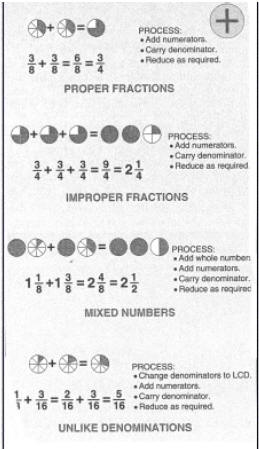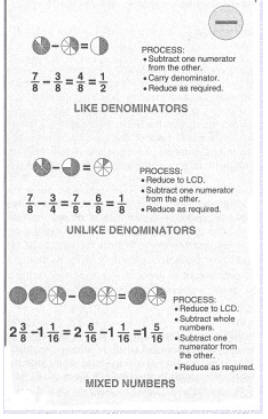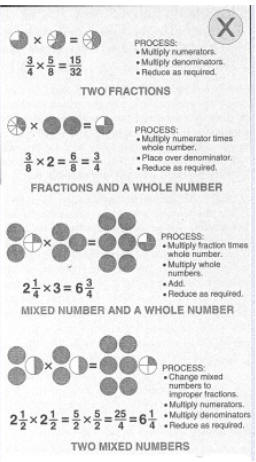Fractions
A fraction i one part of a whole number. The number 1 is
the smallest whole number. Anything smaller
than 1 is a fraction and can be divided into any number of fractional parts.
Fraction are written above
below or on both sides of a fraction bar. Fraction bars may be horizontal or
inclined. The denominator
shows how many parts the whole number has been divided into. The denominator is
the lower (or right
hand) number of the fraction. The numerator shows the number of parts in the
fraction. The numerator
is the upper (or left hand side) number. A proper fraction has a denominator
larger than its numerator.
An improper fraction has a numerator larger then the denominator. A mixed number
is a combination of
a whole number and a fraction
 |
Fractions may be added horizontally or
vertically. Horizontal placement is the most common, as identification of numerators and denominators is easier. Fractions which may be added in- clude proper fractions, improper fractions, mixed numbers, and fractions with unlike denominators. There is a different rule for each of these four combinations. Proper Fractions: Fractions having the same denominator are added by adding the numerators and placing them over the denominator. For example, in the problem 1/3 + 1/3 = 2/3, the numerators (1+1) are added to produce 2. The denominator (3) remains constant. Improper Fraction: Adding Improper Fractions. Fractions Which produce a sum in which the numerator is larger than the denominator (improper fractions) are changed to a mixed num- ber by dividing the numerator by the denominator, recording the quotient obtained, and treating the remainder as a numerator placed over the original denominator. For example, in the prob- lem 3/8 + 3/8 + 3/8 = 9/8, the improper fraction 9/8 is changed to 1 1/8 by dividing 9 by 8. Adding mixed Numbers: To add fractions containing mixed numbers, add the whole num- bers, add the numerators, and carry the denominator. For exam- ple, in the problem 1 1/4 + 3 1/4 + 4 1/4 = 8 3/4, the whole num- ber 1,3,4 are added tp produce 8. The numerators 1+1+1 are added to produce 3, which is placed over the denominator. |
 |
Subtraction of fractions is similar to addition
of fractions. Frac- tions may be subtracted horizontally or vertically. Horizontal placement is the most common, as identification of numerators and denominators is easier. All fractions must have a common denominator before one can be subtracted from another. Frac- tions which may be subtracted include fractions with like denomi- nators, fractions with unlike denominators, and mixed numbers. There is a different rule for each of these three combinations. Subtracting Fractions with Like Denominators: To subtract fractions having the same denominators, subtract one numerator from the other numerator and place over the de- nominator. For example, to subtract 7/16 from 11/16 subtract the numerator 7 from the numerator 11 to get 4. Place the 4 over the denominator 16. Then reduce. Subtracting Fractions with Unlike Denominators: To subtract fractions having unlike denominators, reduce the fractions to their LCD and subtract one numerator from the other. For example, to subtract 7/16 from 3/4, reduce 3/4 to 12/16 and subtract 7/16 to 5/16. Subtracting Mixed Numbers: Subtracting Mixed Numbers. To subtract fractions having mixed numbers, follow the applicable procedure for denominators, sub- tract the numerators, subtract the whole numbers, and if neces- sary, reduce the fraction to its lowest common denominator. |
 |
Fractions may be multiplied horizontally or
vertically. Horizontal placement of fractions is the most common, as identification of nu- merators and denominators is easier. Fractions which may be mul- tiplied include two fractions, fractions and a whole number, a mixed number and a whole number, and two mixed numbers. There is a different rule for each of these four combinations. Multiplying Two Fraction: To multiply two fractions, multiply the numerator of one fraction by the numerator of the other fraction. Do the same with the denomi- nators. Reduce the answer as required. Multiplying Fractions and a Whole Number: To multiply a fraction and a whole number, multiply the numerator of the fraction by the whole number and place over the denomina- tor. Reduce the answer as required. Multiplying a Mixed Number and a Whole Number: Multiplying a Mixed Number and a Whole Number. To multiply a mixed number and a whole number, multiply the fraction of the mixed number by the whole number, multiply the whole numbers, and add the two products. Multiplying Two Mixed numbers: Multiplying Two Mixed Numbers. To multiply two mixed numbers, change both mixed numbers to improper fractions and multiply. |
 |
Fractions are divided horizontally. Fractions
which may be divided in- clude a fraction by a whole number, a mixed number by a whole num- ber, two fractions, a whole number by a fraction, and two mixed num- bers. There is a different rule for each of these five combinations. Dividing a Fraction by a Whole Number: To divide a fraction by a whole number, multiply the denominator of the fraction by the whole number. Dividing a Mixed Number by a Whole number: To divide a mixed number by a whole number, change the mixed num- ber to an improper fraction and multiply the denominator of the im- proper fraction by the whole number. Dividing Two Fractions: To divide two fractions, invert the divisor fraction and multiply the nu- merator by the numerator and the denominator by the denominator. Dividing a whole Number By a Fraction: To divide a whole number by a fraction, change the whole number into fraction form, invert the divisor fraction, and multiply the numerator by the numerator and the denominator by the denominator. Dividing two Mixed Numbers: To divide two mixed numbers, change both mixed numbers to im- proper fractions, invert the divisor fraction, and multiply the numerator by the numerator and the denominator by the denominator. |

